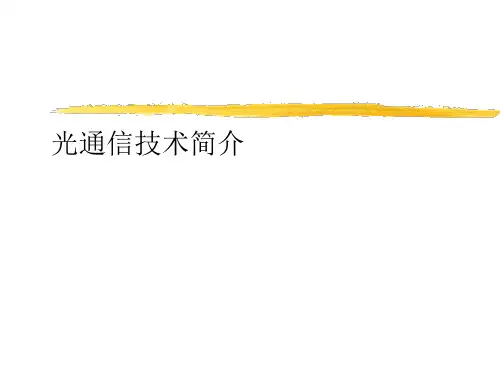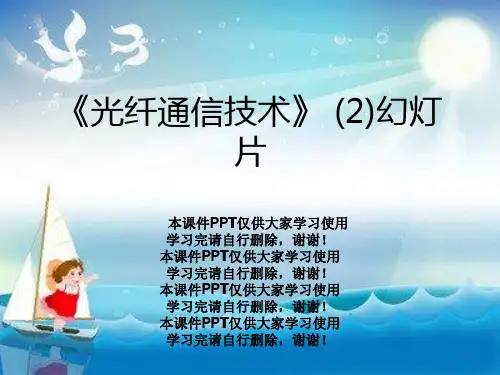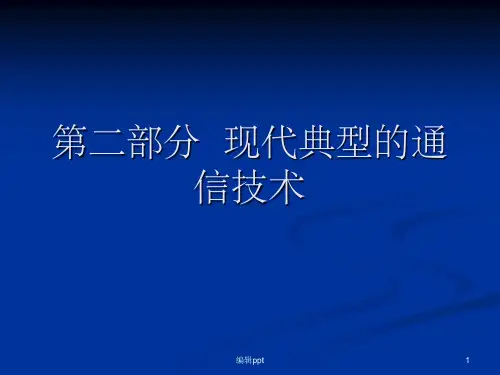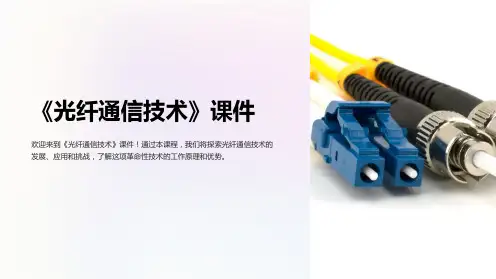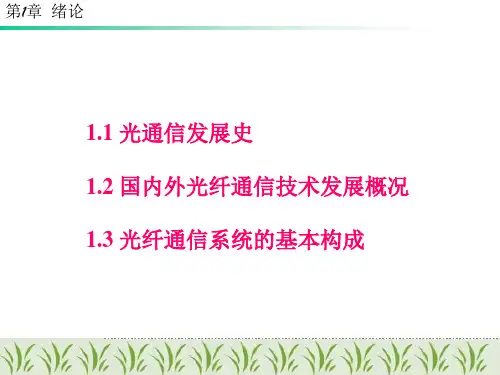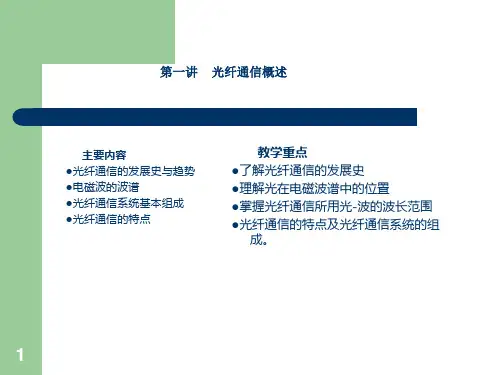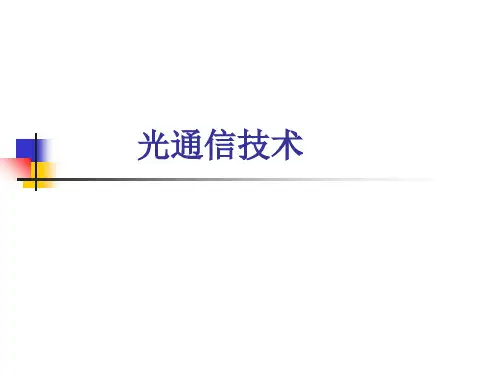- 1、下载文档前请自行甄别文档内容的完整性,平台不提供额外的编辑、内容补充、找答案等附加服务。
- 2、"仅部分预览"的文档,不可在线预览部分如存在完整性等问题,可反馈申请退款(可完整预览的文档不适用该条件!)。
- 3、如文档侵犯您的权益,请联系客服反馈,我们会尽快为您处理(人工客服工作时间:9:00-18:30)。
Department of Optical Engineering
Attenuation and phase shift in total internal reflection
➢ Total internal reflection is not total:
evanescent wave:
Attenuation e-y,
➢ =+j ➢ h2= 2+k2, k=/v
( m )2 ( n )2 2
a
b
➢ If >0, waveguide attenuation occurs, not support
propagation ➢ Cutoff frequency
When
c2
m
a
2
n
b
2
then j 0
➢ Laplacian equation
Department of Optical Engineering
TE and TM in circular waveguide
➢ TE: E(a,,z)=0
TE11
➢ TM: Ez(a,,z)=0
Department of Optical Engineering
( E)
( B)
2E ,
t
2t
Ez ( x, y, z, t ) Ez ( x, y)e j(t z) ,
h2 ( m )2 ( n )2 , m, n integers
a
b
H z H0 cos(m x / a) cos(n y / b)
Ez E0 sin(m x / a) sin(n y / b)
➢ Most important characteristics of transmission are determined by the mode propagation constant, m()
n2k m (ω) n1k
Department of Optical Engineering
➢ At each frequency or wavelength, there exists only a finite number of guided or propagating modes that can carry light energy over a long distance along the fiber. Each of these modes can propagate in the fiber only if the frequency is above the cut-off frequency, cutoff , (or the source wavelength is smaller than the cut-off wavelength) obtained from cut-off condition that is:
Unbounded wavelength =v/f:
free space, no boundary
Guided wavelength g=/[1-(f/fc)2]1/2 : Allow to travel !
Cutoff wavelength c=v/fc :
attenuation/evanescent
Department of Optical Engineering ZJU
TE and TM modes
➢ TE: Ex 0 at y 0,b
Ey 0 at x 0,a
TM: Ez 0 at y 0,b Ez 0 at x 0,a
h2
h2 =
Department of Optical Engineering
➢ Reduce end separation to observe output modes
Multimode
Single mode End separation
Department of Optical Engineering ZJU
Light Propagation in Waveguides
Modes in weak-bounded waveguide
Department of Optical Engineering
Modal Theory of Step Index fiber
➢ General expression of EM-wave in the circular fiber:
➢ Cut-off wavelength ➢ Group velocity ➢ Dispersion
Department of Optical Engineering ZJU
Interesting Observation: when multimode fiber meets single mode fiber
➢ Linear-polarized modes
LP modes
➢ Three types of modes
Guided:
• internally reflected REPETIVELY!:
TE and TM Field
For TM modes, l=0 and m=0 are not possible, TM11 is the lowest TM mode.
Cutoff frequency and wavelength
Ez Ez (x, y)eze j(t z) , 2Ez (x, y) h2Ez (x, y) 0
2 E 2 E 0
2t
Apply to z-component
2 Ez (x, y) h2Ez (x, y) 0
Determined by boundary condition
Department of Optical Engineering
First find Ez and Hz, and you have all the rest components
2
n12 sin 2 i n22
➢ Fresnel formulas
Reflectance
Transmittance
example
Department of Optical Engineering
More about modes
➢ True modes
Natural modes TE, TM
Departmento<f Ocpticaal E/nmgineoerribng/n
How field looks between parallel plates ➢ TM modes
m=1 m=2 m=3
Department of Optical Engineering
What about the field in circular waveguides ➢ No need to prove ez term (why?) ➢ Again you only need to find Ez and Hz
Similarly for the magnetic field,
H z B1 cos kx x B2 sin kx x B3 cos k y y B4 sin k y y e z
Ex
h2
Ez x
j
h2
H z y
Ey
h2
Ez y
j
h2
H z x
Hx
j
h2
Ez y
h2
H z x
Hy
E(,, z, t)
Am Em ( ,, z, t) AmU m ( , )e j (ωt m z )
m
m
H (,, z, t)
Am H m (,, z, t)
AmVm ( , )e j (ωt m z )
m
m
➢ Each of the characteristic solutions is called mth mode of the optical fiber.
➢ Multi-mode fibers are also extensively used for many applications. In these fibers many modes carry the optical signal collectively & simultaneously.
➢ Maxwell’s equations
•D
n • (D2 D1 )
•B 0
n • (B2 B1 ) 0
E B / t
n (E2 E1 ) 0
H J D / t
n (H2 H1 ) k
➢ Rectangular waveguide
( E) 2 E ( • E), J E, D E, B H , ( : conductivity, : permitivity, : permeablity)
Ez c1 cos kx x c2 sin kx x c3 cos k y y c4 sin k y y c5e z c6e z
For the wave traveling in z-direction:
Ez A1 cos kx x A2 sin kx x A3 cos k y y A4 sin k y y e z
Um (, )e j (ωt m z)
m 1,2,3...
➢ It is often sufficient to give the E-field of the mode.
Department of Optical Engineering
Mode propagation constant
➢ The modal field distribution Um(,), and the mode propagation constant, m are obtained from solving the Maxwell’s equations subject to the boundary conditions given by the cross sectional dimensions and the dielectric constants of the fiber.
